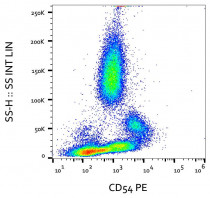ARG53874
anti-CD54 / ICAM1 antibody [MEM-111] (PE)
anti-CD54 / ICAM1 antibody [MEM-111] (PE) for Flow cytometry and Human,Rat,Bovine
Cell Biology and Cellular Response antibody; Developmental Biology antibody; Immune System antibody; Cytotoxic T Cell Surface Study antibody
Overview
| Product Description | PE-conjugated Mouse Monoclonal antibody [MEM-111] recognizes CD54 / ICAM1 |
|---|---|
| Tested Reactivity | Hu, Rat, Bov |
| Tested Application | FACS |
| Specificity | The clone MEM-111 reacts with CD54 (ICAM-1), a 85-110 kDa type I transmembrane glycoprotein (receptor for rhinovirus). The expression of CD54 is upregulated by activation; it is expressed on activated endothelial cells, T lymphocytes, B lymphocytes, monocytes, macrophages, granulocytes and dendritic cells. HLDA VI; WS Code AS A049 |
| Host | Mouse |
| Clonality | Monoclonal |
| Clone | MEM-111 |
| Isotype | IgG2a |
| Target Name | CD54 / ICAM1 |
| Antigen Species | Human |
| Immunogen | Raji human Burkitt's lymphoma cell line |
| Conjugation | PE |
| Alternate Names | CD54; CD antigen CD54; BB2; P3.58; Intercellular adhesion molecule 1; Major group rhinovirus receptor; ICAM-1 |
Application Instructions
| Application Suggestion |
|
||||
|---|---|---|---|---|---|
| Application Note | * The dilutions indicate recommended starting dilutions and the optimal dilutions or concentrations should be determined by the scientist. |
Properties
| Form | Liquid |
|---|---|
| Purification Note | The purified antibody is conjugated with R-Phycoerythrin (PE) under optimum conditions. The conjugate is purified by size-exclusion chromatography and adjusted for direct use. No reconstitution is necessary. |
| Buffer | PBS, 15 mM Sodium azide and 0.2% (w/v) high-grade protease free BSA |
| Preservative | 15 mM Sodium azide |
| Stabilizer | 0.2% (w/v) high-grade protease free BSA |
| Storage Instruction | Aliquot and store in the dark at 2-8°C. Keep protected from prolonged exposure to light. Avoid repeated freeze/thaw cycles. Suggest spin the vial prior to opening. The antibody solution should be gently mixed before use. |
| Note | For laboratory research only, not for drug, diagnostic or other use. |
Bioinformation
| Database Links | |
|---|---|
| Gene Symbol | ICAM1 |
| Gene Full Name | intercellular adhesion molecule 1 |
| Background | This gene encodes a cell surface glycoprotein which is typically expressed on endothelial cells and cells of the immune system. It binds to integrins of type CD11a / CD18, or CD11b / CD18 and is also exploited by Rhinovirus as a receptor. [provided by RefSeq, Jul 2008] |
| Function | ICAM proteins are ligands for the leukocyte adhesion protein LFA-1 (integrin alpha-L/beta-2). During leukocyte trans-endothelial migration, ICAM1 engagement promotes the assembly of endothelial apical cups through ARHGEF26/SGEF and RHOG activation (By similarity). [UniProt] |
| Research Area | Cell Biology and Cellular Response antibody; Developmental Biology antibody; Immune System antibody; Cytotoxic T Cell Surface Study antibody |
| Calculated MW | 58 kDa |
| PTM | Monoubiquitinated, which is promoted by MARCH9 and leads to endocytosis. |
Images (1) Click the Picture to Zoom In
Clone References








